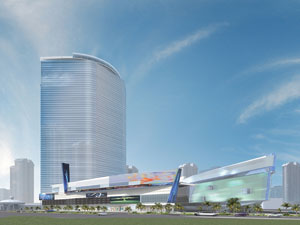 |
| Photo courtesy Tony Illia |
| Despite being 70 percent complete, construction of the $2.9 billion Fontainebleau Las Vegas was halted in mid-2009 due to financial woes. Today, the abandoned project sits collecting dust, with completion nowhere in sight. |
Nationwide, the economy might be on the upswing, leading to more construction work. Las Vegas, however, has yet to bounce back. High unemployment, less discretionary spending, and fewer visitors have stalled several local building projects, including Fontainebleau Las Vegas. Despite being 70 percent complete, construction of the $2.9 billion tower was halted in mid-2009 because the owners were unable to scrape together the money needed to finish the final leg of work. Today, the abandoned resort sits collecting dust, with completion nowhere in sight.

Fontainebleau was to be one of the city’s largest, most unapologetically glamorous hotels. Designed by New York-based Carlos Zapata Studio, with the local firm Bergman Walls & Associates serving as executive architect, the resort was to occupy 25 acres of prime Strip-front real estate where the El Rancho and Algiers casinos once stood. (The venerable resorts were razed in 2000 and 2005, respectively).
Florida high-rise builder Turnberry Associates and a group of investors broke ground on the Fontainebleau in early 2007, at the tail end of Southern Nevada’s real estate boom. The ambitious development called for 3.4 million square feet of enclosed space, the equivalent of 59 football fields, including a 737-foot-tall tower sheathed in cobalt blue glass. The 63-story tower would contain nearly 2,800 hotel rooms and 1,018 residences that would double as guest rooms. Plus, it would include a 100,000-square-foot casino, 3,200-seat performing arts center, 27 restaurant/lounges, 300,000 square feet of shops, a 60,000-square-foot spa modeled after Iceland’s Blue Lagoon (in Reykjavik), and a seven-acre pool deck floating 72 feet over the street.
The tower’s architecture was intended to refer to its iconic Morris Lapidus-designed counterpart in Miami, with a whiplash-curve façade, multi-colored interiors, and a famed “Staircase to Nowhere,” re-imagined by David Collins as a sculptural installation. “Our design team put a great deal of resources and emotion into this project,” says Joel Bergman, chairman of Bergman Walls & Associates.
Construction progressed at a steady pace until things went awry in early 2009. Lenders became increasingly skittish during the financial downturn and reneged on $800 million in pre-approved loans. The money was crucial for finishing the job. The owners responded with a lawsuit, and then sought bankruptcy protection in June 2009. Lawsuits and mechanic’s liens followed. Once employing over 3,300 people during construction, Fontainebleau eventually went into foreclosure. “I have never seen a project come to halt this far into construction,” says Bergman, whose firm is still owed money for work performed.
There was a moment of hope in February 2010, when billionaire investor Carl Icahn bought the half-built project for $150 million. But no construction has occurred since the purchase by Mr. Icahn, who often buys depressed assets and then flips them. Calls to Mr. Icahn’s office seeking comment for this story were not returned.
Some estimates put Fontainebleau’s worth at about $1 billion, yet it still needs $1.5 billion of work in order to open. Icahn has reportedly sold-off the furniture and fixtures and could dispose of the property when market conditions improve.
The rise and fall of Fontainebleau is a familiar refrain in Las Vegas, where a half-dozen Strip projects that began during better times now stand abandoned in various stages of construction. Their future is uncertain. “I don’t think you’re going to see the properties razed; rather, developers are going to wait until the demand returns to finish them,” says Grant Govertsen, an analyst with Las Vegas-based Union Gaming Group. “I have hard time believing that it would resume anytime before 2012. It will take years before it makes sense to put a shovel in the ground again."

Post a comment to this article
Report Abusive Comment